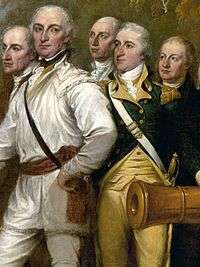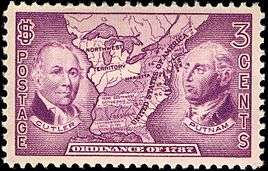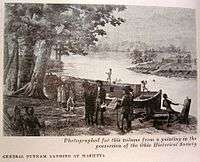Rufus Putnam
| Rufus Putnam | |
|---|---|
 Rufus Putnam | |
| Born |
April 9, 1738 Sutton, Massachusetts |
| Died |
May 4, 1824 (aged 86) Marietta, Ohio |
| Place of burial | Mound Cemetery, Marietta |
| Allegiance |
|
| Service/branch |
Continental Army US Army |
| Years of service |
1775–1783 (Continental Army) 1792–1793 (US Army) |
| Rank |
|
| Relations | Persis Rice (wife) |
| Other work | pioneer to the Ohio Country; founder of Marietta, Ohio; judge of the Northwest Territory; first Surveyor General of the United States |
| Signature |
|
Rufus Putnam (April 9, 1738 – May 4, 1824) was a colonial military officer during the French and Indian War, and a general in the Continental Army during the American Revolutionary War.[1] As an organizer of the Ohio Company, he was instrumental in the initial settling of the Northwest Territory in present-day Ohio following the war.[2]
He was known as "Father of the Northwest Territory"
Early life and career
Putnam was born in Rutland, Massachusetts. Rufus's father Elisha Putnam died when Rufus was 6 or 7, and Rufus temporarily lived with his paternal grandfather in Danvers, Massachusetts. Elisha Putnam and Israel Putnam, who became a renowned general during the American Revolution were cousins. After Rufus Putnam's mother married John Sadler, Rufus lived with his mother and stepfather in Sutton, where the family ran an inn.[3][4]
Putnam served with a Connecticut regiment from 1757 to 1760, during the French and Indian War. During the war, Putnam saw action in the Great Lakes region, and near Lake Champlain.[5][6]
Migration and work
After the war, Putnam relocated to New Braintree, Massachusetts. There, he worked as a millwright from 1761 to 1768.
Marriage and family
Established at work, in April 1761 Putnam married Elizabeth Ayers, the daughter of William Ayers, esquire of the Second Precinct of Brookfield (now North Brookfield), Massachusetts. Elizabeth died in 1762, possibly in childbirth.
On January 10, 1765 Putnam married again, to Persis Rice, the daughter of Zebulon Rice of Westborough, Massachusetts.[7]
Farmer and surveyor
While Putnam worked as a millwright, he devoted his free time to self-education, studying geography, mathematics, and surveying.
In 1769, Putnam became a farmer and surveyor. Rufus Putnam, along with his cousin Israel Putnam and two others, traveled in 1773 to survey near present-day Pensacola, Florida. There, Putnam surveyed and chartered lands along the Mississippi River, which the Crown was going to grant to veterans of the French and Indian War in lieu of payment for their service.
Revolutionary War

After the battle of Lexington, Putnam enlisted the same day, on April 19, 1775, in one of Massachusett's first revolutionary regiments. Putnam later was commissioned in the Continental Army as a Lieutenant Colonel, under the command of David Brewer. Brewer's regiment first engaged with the British Army in Roxbury, Massachusetts. Drawing from his knowledge and skill as a millwright, Putnam constructed the fortifications necessary to obtain victory. His fortifications provided an advantage to the Continental Army, which secured victories at Sewall's Point, Providence, New Port, Dorchester Heights, Long Island, and West Point.[8]
General Washington appointed Putnam to be the Chief of Engineers of the Works of New York. He was soon promoted to engineer with the rank of colonel. When in December 1776 the Continental Congress rejected his proposition to establish a national corps of engineers, Putnam resigned.
He reenlisted in the Northern Army and served under Major General Horatio Gates. Putnam commanded two regiments in the battle of Saratoga. He continued to work on critical fortifications, including Fort Putnam at West Point in 1778. In 1779 Putnam served under Major General Anthony Wayne in the Corps of Light Infantry following the capture of Stony Point, commanding the 4th Regiment. Putnam's remaining military career was less eventful. In January 1783 he was commissioned as brigadier general.
Post-war activities
After the war was over, Putnam returned to Rutland, Massachusetts. In 1780 he had bought a farm confiscated from a Loyalist, and he settled there. He returned to working as a surveyor, inspecting lands in Maine (then part of Massachusetts). Putnam was a strong advocate of granting lands to veterans of the Revolution. He was one of the authors of the army's Newbergh Petition, which was submitted to Congress requesting land disbursements. There was pent-up land hunger among younger men in New England, where topography and long settlement restricted buying land.
The Ohio Company
Putnam's advocacy for land grants led him, with partners, to establish the Ohio Company of Associates for the purchase and settlement of Western lands.[9][10] He established the Company in Boston on March 3, 1786 together with Benjamin Tupper, Samuel Holden Parsons, and Manasseh Cutler.[11] Its primary purpose was to settle the Northwest Territory, roughly the lands between the Appalachian Mountains and the Mississippi River, which was ceded to the US by Great Britain under the Treaty of Paris (1783).
After passage of the Northwest Ordinance to organize the territory, the Company bought about 1,000,000 acres (4,000 km2) of land north of the Ohio River, between the present day sites of Marietta, Ohio, and Huntington, West Virginia. Cutler had tried to purchase all the land between the Ohio and Scioto rivers, but the western half was optioned by the Scioto Company. It later failed without having purchased any of the land.
Later life
In 1788 Putnam led a group of Revolutionary veterans to settle the land in what became Ohio. These pioneers arrived at the confluence of the Ohio and Muskingum rivers on April 7, 1788, where they established Marietta, Ohio as the first permanent United States settlement in the Northwest Territory. Putnam was appointed to serve as one of three judges of the Northwest Territory after Samuel Holden Parsons died.[12]
The territory had been historically occupied by Native American tribes, and more were driven west by colonial encroachment before the Revolution. As they had not ceded any land, they came into conflict with the arriving pioneers. They organized a coalition of tribes to try to expel the Americans from their territory.
From 1792 to 1793, Putnam served as a brigadier general in Anthony Wayne's Ohio campaign against these Native American tribes, including Shawnee, Lenape and Seneca, who were ultimately defeated. In 1796, Putnam was appointed by the President as the first Surveyor General of the United States, a position he held until 1803. As Ohio residents organized to write a constitution and be admitted as a state, in 1802 Putnam was elected a Washington county delegate to the Ohio Constitutional Convention.[13]
He was appointed as a Trustee of Ohio University, where he served for two decades, from 1804 to 1824. It was constructed on public lands, under the terms of the Northwest Ordinance of 1787.[14] Long participating in the Masons, a fraternal organization that expanded in the early nineteenth century, in 1808 Putnam was elected the first Grand Master of the Grand Lodge of Free & Accepted Masons of Ohio.[15]

Putnam died on May 4, 1824. He was buried at Mound Cemetery in Marietta, Ohio.[16]
Legacy and honors

Issue of 1937
Rufus Putnam is depicted on a commemorative stamp issued on July 13, 1937 by the U.S. Post Office which commemorated the 150th anniversary of the North West Ordinance of 1787. The engraving on the stamp depicts a map of the United States at the time with the North West Territory between the figures of Putnam (right) and Manasseh Cutler.[17]
Putnam's home in Marietta has been designated a National Historic Landmark in his honor. His home in Rutland, Massachusetts (the General Rufus Putnam House) is on the National Register of Historic Homes and is currently being operated as a B&B. The town of Putnam, Ohio (now a part of Zanesville, Ohio) was named for him. Fort Putnam (built by Rufus Putnam) is part of the U.S. Military Academy at West Point, New York. One of his grandsons, Catharinus Putnam Buckingham, served as a brigadier general in the Union Army during the American Civil War.
References
- ↑ Heitman, Officers of the Continental Army, 455.
- ↑ Benedict, William A. and Tracy, Hiram A. History of the Town of Sutton, Massachusetts from 1704 to 1876, pp. 244-6, Sanford & Company, Worcester, Massachusetts, 1878.
- ↑ William A. benedict, Hiram A. Tracy, History of the Town of Sutton, Massachusetts, from 1704 to 1876, 1876, p. 244
- ↑ Fred Milligan, Ohio's Founding Fathers, 2003, p. 9
- ↑ Rufus Putnam, Journal of Gen. Rufus Putnam Kept in Northern New York During Four Campaigns of the Old French and Indian War, 1757–1760, 1886, p. 72
- ↑ Mark W. Royston, The Faces Behind the Bases, 2009, p. 173
- ↑ "Persis Rice in ERA database". Edmund Rice (1638) Association. Retrieved 5 July 2013.
- ↑ Benedict, William A. and Tracy, Hiram A. History of the Town of Sutton, Massachusetts from 1704 to 1876, pp. 244-6, Sanford & Company, Worcester, Massachusetts, 1878.
- ↑ Hulbert, Archer Butler: The Records of the Original Proceedings of the Ohio Company, Volume I, Marietta Historical Commission, Marietta, Ohio (1917).
- ↑ Hulbert, Archer Butler: The Records of the Original Proceedings of the Ohio Company, Volume II, Marietta Historical Commission, Marietta, Ohio (1917).
- ↑ Benedict, William A. and Tracy, Hiram A. History of the Town of Sutton, Massachusetts from 1704 to 1876, pp. 244-6, Sanford & Company, Worcester, Massachusetts, 1878.
- ↑ Burnet, Jacob (1847). Notes on the Early Settlement of the North-western Territory. Cincinnati: Derby, Bradley and Company. p. 40.
- ↑ "First Constitutional Convention, Convened November 1, 1802". Ohio Archaeological and Historical Publications. V: 131–32. 1896.
- ↑ Walker, Charles M. (1869). History of Athens County, Ohio And Incidentally of the Ohio Land Company and the First Settlement of the State at Marietta etc. Robert Clarke & Company. pp. 346–48.
- ↑ "Past Grand Masters – 1808 Rufus Putnam". Grand Lodge of Ohio. Retrieved 2012-12-21.
- ↑ Rufus Putnam at Find a Grave
- ↑ "Ordinance of 1787 Sesquicentennial Issue". Smithsonian National Postal Museum. Retrieved July 16, 2014.
Bibliography
- Barker, Joseph: Recollections of the First Settlement of Ohio, Marietta College, Marietta, Ohio (1958); original manuscript written late in Joseph Barker's life, prior to his death in 1843.
- Buell, Rowena, ed.: The Memoirs of Rufus Putnam and Certain Official Papers and Correspondence, Houghton, Mifflin, and Co., The Riverside Press, Cambridge, Massachusetts (1903). Available online as part of the California Digital Library at The memoirs of Rufus Putnam and certain official papers and correspondence
- Dawes, E. C.: Journal of Gen. Rufus Putnam kept in Northern New York during Four Campaigns of the old French and Indian War, Joel Munsell’s Sons, Albany, New York (1886).
- Heitman, Francis B.: Officers of the Continental Army during the War of the Revolution, Rare Book Shop Publishing Co., Washington, D.C. (1914).
- Hildreth, S. P.: Biographical and Historical Memoirs of the Early Pioneer Settlers of Ohio, H. W. Derby and Co., Cincinnati, Ohio (1852).
- Hildreth, S. P.: Pioneer History: Being an Account of the First Examinations of the Ohio Valley, and the Early Settlement of the Northwest Territory, H. W. Derby and Co., Cincinnati, Ohio (1848). This historical book is available online via the Google Books Library Project at Early Settlement of the Northwest Territory.
- Hulbert, Archer Butler: The Records of the Original Proceedings of the Ohio Company, Volume I, Marietta Historical Commission, Marietta, Ohio (1917). This historical book is available online via the Google Books Library Project at Ohio Company, Volume I.
- Hulbert, Archer Butler: The Records of the Original Proceedings of the Ohio Company, Volume II, Marietta Historical Commission, Marietta, Ohio (1917). This historical book is available online via the Google Books Library Project at Ohio Company, Volume II.
- Leiter, M. T.: Biographical Sketches of the Generals of the Continental Army of the Revolution, University Press: John Wilson and Son, Cambridge, Massachusetts (1889).
- Summers, Thomas J.: History of Marietta, The Leader Publishing Co., Marietta, Ohio (1903). This historical book is available online via the Google Books Library Project at History of Marietta.
- Randall, Emilius Oviatt (1850–1919): Rufus Putnam Memorial Association, Ohio Archæological and Historical Society Publications: Volume 20 [1911], pp. 123–33.
External links
- U.S. Army Corps of Engineers History: Commanders
-
 Texts on Wikisource:
Texts on Wikisource:
- Fiske, John (1900). "Putnam, Israel". Appletons' Cyclopædia of American Biography.
- "Putnam, Rufus". New International Encyclopedia. 1905.
- "Putnam, Rufus". Encyclopædia Britannica (11th ed.). 1911.
- "Putnam, Rufus". Encyclopedia Americana. 1920.
- Rufus Putnam at Ohio History Central
- Rufus Putnam house website
| Military offices | ||
|---|---|---|
| Preceded by Richard Gridley |
Chief of Engineers 1776 |
Succeeded by Louis Lebègue Duportail |
| Legal offices | ||
| Preceded by Samuel Holden Parsons |
Judge of the Northwest Territory March 1790 – December, 1796 |
Succeeded by Joseph Gilman |
| Government offices | ||
| Preceded by new office |
Surveyor General of the Northwest Territory 1797–1803 |
Succeeded by Jared Mansfield |
